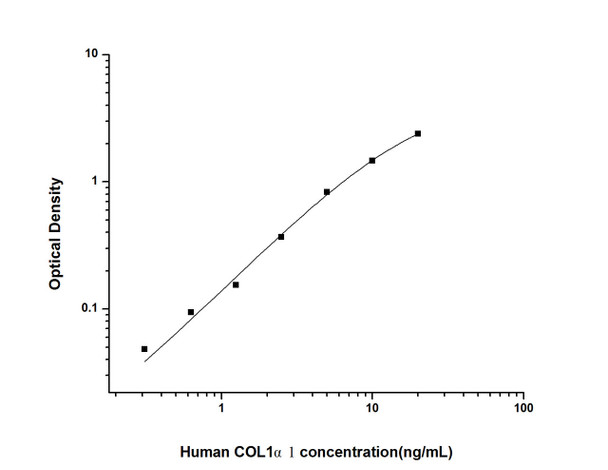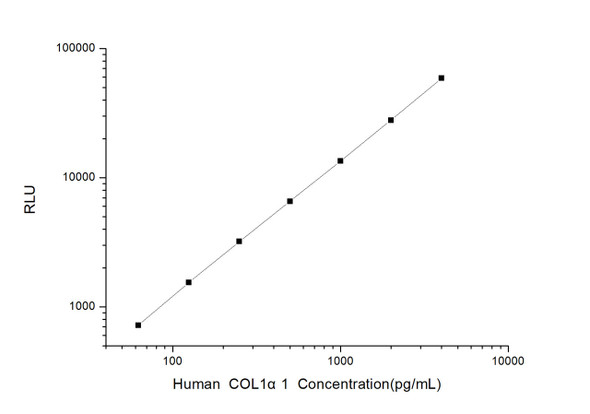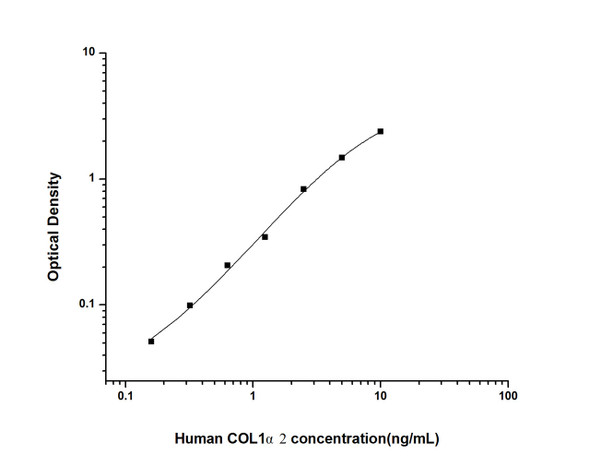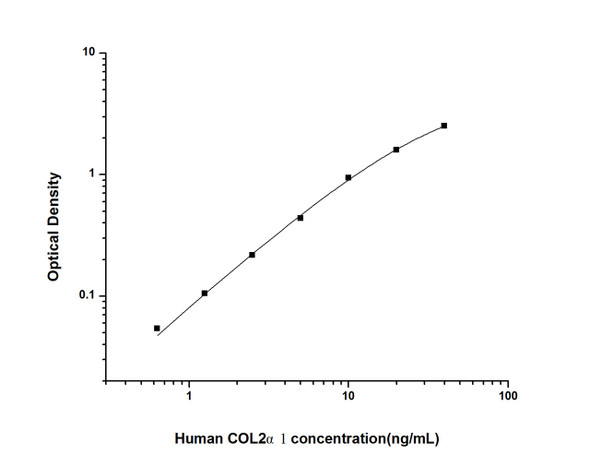Human Cell Biology ELISA Kits 2
Human COL1 alpha1 (Collagen Type I Alpha 1) ELISA Kit (HUES01997)
- SKU:
- HUES01997
- Product Type:
- ELISA Kit
- Size:
- 96 Assays
- Uniprot:
- P02452
- Sensitivity:
- 0.19ng/mL
- Range:
- 0.31-20ng/mL
- ELISA Type:
- Sandwich
- Reactivity:
- Human
- Sample Type:
- Serum, plasma and other biological fluids
- Research Area:
- Cell Biology
Description
| Assay type: | Sandwich |
| Format: | 96T |
| Assay time: | 4.5h |
| Reactivity: | Human |
| Detection Method: | Colormetric |
| Detection Range: | 0.31-20 ng/mL |
| Sensitivity: | 0.19 ng/mL |
| Sample Volume Required Per Well: | 100µL |
| Sample Type: | Serum, plasma and other biological fluids |
| Specificity: | This kit recognizes Human COL1 alpha1 in samples. No significant cross-reactivity or interference between Human COL1 alpha1 and analogues was observed. |
This ELISA kit uses Sandwich-ELISA as the method. The micro ELISA plate provided in this kit has been pre-coated with an antibody specific to Human COL1 alpha1. Standards or samples are added to the appropriate micro ELISA plate wells and combined with the specific antibody. Then a biotinylated detection antibody specific for Human COL1 alpha1 and Avidin-Horseradish Peroxidase (HRP) conjugate are added to each micro plate well successively and incubated. Free components are washed away. The substrate solution is added to each well. Only those wells that contain Human COL1 alpha1, biotinylated detection antibody and Avidin-HRP conjugate will appear blue in color. The enzyme-substrate reaction is terminated by adding Stop Solution and the color turns yellow. The optical density (OD) is measured spectrophotometrically at a wavelength of 450 nm ± 2 nm. The OD value is proportional to the concentration of Human COL1 alpha1. The concentration of Human COL1 alpha1 in samples can be calculated by comparing the OD of the samples to the standard curve.
| UniProt Protein Function: | COL1A1: Type I collagen is a member of group I collagen (fibrillar forming collagen). Defects in COL1A1 are the cause of Caffey disease (CAFFD); also known as infantile cortical hyperostosis. Caffey disease is characterized by an infantile episode of massive subperiosteal new bone formation that typically involves the diaphyses of the long bones, mandible, and clavicles. The involved bones may also appear inflamed, with painful swelling and systemic fever often accompanying the illness. The bone changes usually begin before 5 months of age and resolve before 2 years of age. Defects in COL1A1 are a cause of Ehlers-Danlos syndrome type 1 (EDS1); also known as Ehlers-Danlos syndrome gravis. EDS is a connective tissue disorder characterized by hyperextensible skin, atrophic cutaneous scars due to tissue fragility and joint hyperlaxity. EDS1 is the severe form of classic Ehlers-Danlos syndrome. Defects in COL1A1 are the cause of Ehlers-Danlos syndrome type 7A (EDS7A); also known as autosomal dominant Ehlers-Danlos syndrome type VII. EDS is a connective tissue disorder characterized by hyperextensible skin, atrophic cutaneous scars due to tissue fragility and joint hyperlaxity. EDS7A is marked by bilateral congenital hip dislocation, hyperlaxity of the joints, and recurrent partial dislocations. Defects in COL1A1 are a cause of osteogenesis imperfecta type 1 (OI1). A dominantly inherited connective tissue disorder characterized by bone fragility and blue sclerae. Osteogenesis imperfecta type 1 is non-deforming with normal height or mild short stature, and no dentinogenesis imperfecta. Defects in COL1A1 are a cause of osteogenesis imperfecta type 2 (OI2); also known as osteogenesis imperfecta congenita. A connective tissue disorder characterized by bone fragility, with many perinatal fractures, severe bowing of long bones, undermineralization, and death in the perinatal period due to respiratory insufficiency. Defects in COL1A1 are a cause of osteogenesis imperfecta type 3 (OI3). A connective tissue disorder characterized by progressively deforming bones, very short stature, a triangular face, severe scoliosis, grayish sclera, and dentinogenesis imperfecta. Defects in COL1A1 are a cause of osteogenesis imperfecta type 4 (OI4); also known as osteogenesis imperfecta with normal sclerae. A connective tissue disorder characterized by moderately short stature, mild to moderate scoliosis, grayish or white sclera and dentinogenesis imperfecta. Genetic variations in COL1A1 are a cause of susceptibility to osteoporosis (OSTEOP); also known as involutional or senile osteoporosis or postmenopausal osteoporosis. Osteoporosis is characterized by reduced bone mass, disruption of bone microarchitecture without alteration in the composition of bone. Osteoporotic bones are more at risk of fracture. A chromosomal aberration involving COL1A1 is found in dermatofibrosarcoma protuberans. Translocation t(17;22)(q22;q13) with PDGF. Belongs to the fibrillar collagen family. |
| UniProt Protein Details: | Protein type:Extracellular matrix; Secreted, signal peptide; Secreted Chromosomal Location of Human Ortholog: 17q21. 33 Cellular Component: extracellular matrix; Golgi apparatus; extracellular space; endoplasmic reticulum lumen; collagen type I; extracellular region; secretory granule Molecular Function:identical protein binding; protein binding; platelet-derived growth factor binding; metal ion binding; extracellular matrix structural constituent Biological Process: response to peptide hormone stimulus; intramembranous ossification; extracellular matrix organization and biogenesis; response to cAMP; collagen fibril organization; positive regulation of transcription, DNA-dependent; embryonic skeletal development; response to estradiol stimulus; response to corticosteroid stimulus; extracellular matrix disassembly; protein transport; sensory perception of sound; visual perception; skeletal development; collagen biosynthetic process; endochondral ossification; response to drug; blood vessel development; receptor-mediated endocytosis; platelet activation; skin morphogenesis; osteoblast differentiation; collagen catabolic process; response to hyperoxia; response to hydrogen peroxide; blood coagulation; leukocyte migration; positive regulation of cell migration Disease: Osteogenesis Imperfecta, Type I; Ehlers-danlos Syndrome, Type Vii, Autosomal Dominant; Osteogenesis Imperfecta, Type Ii; Ehlers-danlos Syndrome, Type I; Osteogenesis Imperfecta, Type Iii; Osteoporosis; Caffey Disease; Osteogenesis Imperfecta, Type Iv |
| NCBI Summary: | This gene encodes the pro-alpha1 chains of type I collagen whose triple helix comprises two alpha1 chains and one alpha2 chain. Type I is a fibril-forming collagen found in most connective tissues and is abundant in bone, cornea, dermis and tendon. Mutations in this gene are associated with osteogenesis imperfecta types I-IV, Ehlers-Danlos syndrome type VIIA, Ehlers-Danlos syndrome Classical type, Caffey Disease and idiopathic osteoporosis. Reciprocal translocations between chromosomes 17 and 22, where this gene and the gene for platelet-derived growth factor beta are located, are associated with a particular type of skin tumor called dermatofibrosarcoma protuberans, resulting from unregulated expression of the growth factor. Two transcripts, resulting from the use of alternate polyadenylation signals, have been identified for this gene. [provided by R. Dalgleish, Feb 2008] |
| UniProt Code: | P02452 |
| NCBI GenInfo Identifier: | 296439504 |
| NCBI Gene ID: | 1277 |
| NCBI Accession: | P02452. 5 |
| UniProt Related Accession: | P02452 |
| Molecular Weight: | |
| NCBI Full Name: | Collagen alpha-1(I) chain |
| NCBI Synonym Full Names: | collagen type I alpha 1 chain |
| NCBI Official Symbol: | COL1A1 |
| NCBI Official Synonym Symbols: | OI1; OI2; OI3; OI4; EDSC; EDSARTH1 |
| NCBI Protein Information: | collagen alpha-1(I) chain |
| UniProt Protein Name: | Collagen alpha-1(I) chain |
| UniProt Synonym Protein Names: | Alpha-1 type I collagen |
| UniProt Gene Name: | COL1A1 |
| UniProt Entry Name: | CO1A1_HUMAN |
As the OD values of the standard curve may vary according to the conditions of the actual assay performance (e. g. operator, pipetting technique, washing technique or temperature effects), the operator should establish a standard curve for each test. Typical standard curve and data is provided below for reference only.
| Concentration (ng/mL) | O.D | Average | Corrected |
| 20 | 2.429 2.463 | 2.446 | 2.387 |
| 10 | 1.5 1.538 | 1.519 | 1.46 |
| 5 | 0.896 0.88 | 0.888 | 0.829 |
| 2.5 | 0.41 0.444 | 0.427 | 0.368 |
| 1.25 | 0.227 0.199 | 0.213 | 0.154 |
| 0.63 | 0.154 0.152 | 0.153 | 0.094 |
| 0.31 | 0.099 0.115 | 0.107 | 0.048 |
| 0 | 0.057 0.061 | 0.059 | -- |
Precision
Intra-assay Precision (Precision within an assay): 3 samples with low, mid range and high level Human COL1 alpha1 were tested 20 times on one plate, respectively.
Inter-assay Precision (Precision between assays): 3 samples with low, mid range and high level Human COL1 alpha1 were tested on 3 different plates, 20 replicates in each plate.
| Intra-assay Precision | Inter-assay Precision | |||||
| Sample | 1 | 2 | 3 | 1 | 2 | 3 |
| n | 20 | 20 | 20 | 20 | 20 | 20 |
| Mean (ng/mL) | 1.00 | 3.05 | 8.08 | 1.00 | 2.83 | 8.21 |
| Standard deviation | 0.06 | 0.16 | 0.38 | 0.07 | 0.16 | 0.43 |
| C V (%) | 6.00 | 5.25 | 4.70 | 7.00 | 5.65 | 5.24 |
Recovery
The recovery of Human COL1 alpha1 spiked at three different levels in samples throughout the range of the assay was evaluated in various matrices.
| Sample Type | Range (%) | Average Recovery (%) |
| Serum (n=5) | 87-97 | 92 |
| EDTA plasma (n=5) | 88-102 | 94 |
| Cell culture media (n=5) | 90-101 | 95 |
Linearity
Samples were spiked with high concentrations of Human COL1 alpha1 and diluted with Reference Standard & Sample Diluent to produce samples with values within the range of the assay.
| Serum (n=5) | EDTA plasma (n=5) | Cell culture media (n=5) | ||
| 1:2 | Range (%) | 95-111 | 89-102 | 88-103 |
| Average (%) | 103 | 96 | 94 | |
| 1:4 | Range (%) | 88-102 | 81-95 | 83-97 |
| Average (%) | 96 | 88 | 88 | |
| 1:8 | Range (%) | 89-100 | 80-93 | 88-100 |
| Average (%) | 95 | 86 | 95 | |
| 1:16 | Range (%) | 92-104 | 79-91 | 88-101 |
| Average (%) | 97 | 85 | 94 |
An unopened kit can be stored at 4°C for 1 month. If the kit is not used within 1 month, store the items separately according to the following conditions once the kit is received.
| Item | Specifications | Storage |
| Micro ELISA Plate(Dismountable) | 8 wells ×12 strips | -20°C, 6 months |
| Reference Standard | 2 vials | |
| Concentrated Biotinylated Detection Ab (100×) | 1 vial, 120 µL | |
| Concentrated HRP Conjugate (100×) | 1 vial, 120 µL | -20°C(shading light), 6 months |
| Reference Standard & Sample Diluent | 1 vial, 20 mL | 4°C, 6 months |
| Biotinylated Detection Ab Diluent | 1 vial, 14 mL | |
| HRP Conjugate Diluent | 1 vial, 14 mL | |
| Concentrated Wash Buffer (25×) | 1 vial, 30 mL | |
| Substrate Reagent | 1 vial, 10 mL | 4°C(shading light) |
| Stop Solution | 1 vial, 10 mL | 4°C |
| Plate Sealer | 5 pieces | |
| Product Description | 1 copy | |
| Certificate of Analysis | 1 copy |
- Set standard, test sample and control (zero) wells on the pre-coated plate and record theirpositions. It is recommended to measure each standard and sample in duplicate. Note: addall solutions to the bottom of the plate wells while avoiding contact with the well walls. Ensuresolutions do not foam when adding to the wells.
- Aliquot 100 µL of standard solutions into the standard wells.
- Add 100 µL of Sample / Standard dilution buffer into the control (zero) well.
- Add 100 µL of properly diluted sample (serum, plasma, tissue homogenates and otherbiological fluids) into test sample wells.
- Cover the plate with the sealer provided in the kit and incubate for 90 min at 37 °C.
- Aspirate the liquid from each well, do not wash. Immediately add 100 µL of BiotinylatedDetection Ab working solution to each well. Cover the plate with a plate seal and gently mix. Incubate for 1 hour at 37 °C.
- Aspirate or decant the solution from the plate and add 350 µL of wash buffer to each welland incubate for 1-2 minutes at room temperature. Aspirate the solution from each well andclap the plate on absorbent filter paper to dry. Repeat this process 3 times. Note: a microplatewasher can be used in this step and other wash steps.
- Add 100 µL of HRP Conjugate working solution to each well. Cover with a plate seal andincubate for 30 min at 37 °C.
- Aspirate or decant the solution from each well. Repeat the wash process for five times asconducted in step 7.
- Add 90 µL of Substrate Reagent to each well. Cover with a new plate seal and incubate forapproximately 15 min at 37 °C. Protect the plate from light. Note: the reaction time can beshortened or extended according to the actual color change, but not by more than 30min.
- Add 50 µL of Stop Solution to each well. Note: Adding the stop solution should be done inthe same order as the substrate solution.
- Determine the optical density (OD value) of each well immediately with a microplate readerset at 450 nm.






